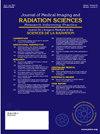Role of MRI in diagnosing vestibulocochlear nerve disorders: A narrative literature review of imaging techniques, current standards, and challenges
IF 1.3
Q3 RADIOLOGY, NUCLEAR MEDICINE & MEDICAL IMAGING
Journal of Medical Imaging and Radiation Sciences
Pub Date : 2025-04-19
DOI:10.1016/j.jmir.2025.101915
引用次数: 0
Abstract
Background
Vestibulocochlear nerve (VCN) disorders are still one of the most challenging diagnoses due to their wide range of clinical manifestations, from hearing loss to balance dysfunction. Radiographers need to be competent in various advanced magnetic resonance imaging (MRI) techniques so that they may optimize examinations to enhance diagnostic sensitivity.
Purpose
This review article discusses the role of MRI in diagnosing disorders of VCN, with an emphasis on advances in imaging protocols, implications for the radiographer, and how such techniques will be integrated into clinical practice.
Key findings
MRI, especially three-dimensional T2-weighted sequences, diffusion-weighted imaging, and magnetic resonance neurography, allows the accurate imaging of VCN pathologies beyond what was possible in traditional functional tests such as pure-tone audiometry and videonystagmography. These are essential in delineating subtle lesions, guiding clinical decisions, and enhancing patient outcomes.
Conclusion
Diagnosis of VCN disorders highly depends on advanced imaging techniques. Radiographers will play an important role in the optimization of imaging protocols and minimization of artifacts, thereby embracing emerging MRI approaches. Their expertise ensures accurate visualization and early detection of VCN pathologies, overcoming challenges such as patient motion and high costs. Collaboration with clinicians and radiologists remains vital for improving diagnostic outcomes and patient care.
MRI在诊断前庭耳蜗神经疾病中的作用:影像学技术、当前标准和挑战的叙述性文献综述
前庭耳蜗神经障碍(VCN)由于其广泛的临床表现,从听力损失到平衡功能障碍,仍然是最具挑战性的诊断之一。放射技师需要掌握各种先进的磁共振成像技术,以便他们可以优化检查以提高诊断灵敏度。目的:本文讨论了MRI在诊断VCN疾病中的作用,重点介绍了成像方案的进展,对放射技师的影响,以及如何将这些技术融入临床实践。smri,特别是三维t2加权序列、弥散加权成像和磁共振神经成像,可以精确成像VCN病变,这是传统功能测试(如纯音测听和视频震图)无法做到的。这些在描述细微病变、指导临床决策和提高患者预后方面是必不可少的。结论VCN病变的诊断高度依赖于先进的影像学技术。放射技师将在优化成像方案和最小化伪影方面发挥重要作用,从而拥抱新兴的MRI方法。他们的专业知识确保了VCN病理的准确可视化和早期检测,克服了患者运动和高成本等挑战。与临床医生和放射科医生的合作对于改善诊断结果和患者护理仍然至关重要。
本文章由计算机程序翻译,如有差异,请以英文原文为准。
求助全文
约1分钟内获得全文
求助全文
来源期刊

Journal of Medical Imaging and Radiation Sciences
RADIOLOGY, NUCLEAR MEDICINE & MEDICAL IMAGING-
CiteScore
2.30
自引率
11.10%
发文量
231
审稿时长
53 days
期刊介绍:
Journal of Medical Imaging and Radiation Sciences is the official peer-reviewed journal of the Canadian Association of Medical Radiation Technologists. This journal is published four times a year and is circulated to approximately 11,000 medical radiation technologists, libraries and radiology departments throughout Canada, the United States and overseas. The Journal publishes articles on recent research, new technology and techniques, professional practices, technologists viewpoints as well as relevant book reviews.
 求助内容:
求助内容: 应助结果提醒方式:
应助结果提醒方式:


